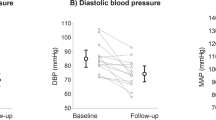Abstract
We investigated common carotid artery blood flow in 99 elderly nursing home residents using an ultrasonic quantitative blood flow measurement system. Systolic velocity and end-diastolic velocity were obtained from the waveform and classified, using the end-diastolic/systolic volume as Type A which is normal flow (>20% bilaterally), Type B which is unilateral decreased flow (<20% unilaterally), Type C which is bilateral decreased flow (<20% bilaterally), Type D which is Type C plus a saw tooth pattern and Type E which is no diastolic pattern, i.e. a value of 0 unilaterally or bilaterally. Five per cent of subjects showed Type A of blood flow velocity waveform (normal flow pattern) and about 40% showed Type E (no diastolic pattern). The subjects were divided into three groups according to blood flow velocity waveform. Groups 1, 2 and 3 showed Types A or B, C or D, and E, respectively. The total blood flow volume and mean blood flow velocity of Group 1 were significantly higher than those of Groups 2 and 3 in both the supine and sitting positions. Although both total blood flow volume and mean blood flow velocity of Group 1 decreased significantly in postural change, those of Groups 2 and 3 did not change. These results suggest that total blood flow volume and mean blood flow velocity decrease in proportion to changes in the blood flow velocity waveform.
Similar content being viewed by others
References
Yoshimura S, Kodaira K, Fujishiro K, Furuhata H. A newly developed non-invasive technique measurements of blood flow—with special reference to the measurement of carotid arterial blood flow.Jikei Med J 1981;28: 241–256.
Furuhata H. A non-invasive and quantitative method of measuring the cerebral arteriosclerosis by simulation technique.Jikei Med J 1982;29: 209–224.
Uematsu S, Yang A, Preziosi J, Kouba R, Toung JJK. Measurement of carotid blood flow in man and its clinical application.Stroke 1983;14: 256–266.
Rutherford RB, Hiatt WR, Kreutzer EW. The use of velocity wave form analysis in the diagnosis of carotid artery occlusive disease.Surgery 1977;82: 695–702.
Yuhi F. Diagnostic characteristics of intracranial lesions with ultrasonic doppler sonography on the common carotid artery.Med J Kagoshima Univ 1987;39: 183–225 (in Japanese with English abstract).
Evans JM, Skidmore R, Luckman NP, Wells PNT. A new approach to the noninvasive measurement of cardiac output using an annular array Doppler technique—I. Theoretical considerations and ultrasonic fields.Ultrasound Med Biol 1989;15: 169–178.
Evans JM, Skidmore R, Baker JD, Wells PNT. A new approach to the non-invasive measurement of cardiac output using an annular array Doppler technique—II. Practical implementation and results.Ultrasound Med Biol 1989;15: 179–187.
Blackshear WM Jr, Phillips DJ, Chikos PM, Harley JD, Thiele BL, Strandness DE Jr. Carotid artery velocity patterns in normal and stenotic vessels.Stroke 1980;11: 67–71.
Humber PR, Leopold GR, Wickbom IG, Bernstein EF. Ultrasonic imaging of the carotid arterial system.Am J Surgery 1980;140: 199–202.
Rittgers SE, Thornhill BM, Barnes RW. Quantitative analysis of carotid artery doppler spectral waveforms: diagnostic value of parameters.Ultrasound Med Biol 1983;9: 255–264.
Sekimoto H, Matsumoto M, Goriya Y, Nakano T, Matsumoto M, Lin K, Tuchiya T, Okuizumi M, Natto M, Shimizu T, Matsubara J. Evaluation of common carotid blood flow volume in elders studied with a two-dimensional echographically guided ultrasonic blood flow-meter.Jpn J Geriat 1988;25: 38–43 (in Japanese with English abstract).
Shiraishi J, Inaoka H, Okuda J, Kaneko J. Cerebral circulation in the aged with organic dementia.Jpn J Geriat 1979;16: 7–16 (in Japanese with English abstract).
Uematsu S, Folstein M. Carotid blood flow measured by an ultrasonic volume flow meter in carotid stenosis and patients with dementia.J Neurol Neurosurg Psychiatry 1985;48: 1230–1233.
Nagatomo I, Nagase F, Akasaki Y, Matsumoto K. Urinary incontinence and its effects in Japanese nursing home residents—three-year follow-up.Asian Med J 1991;34: 293–299.
Ewing DJ, Hume L, Campbell IW, Murray A, Neilson JMM, Clarke BF. Autonomic mechanisms in the initial heart rate response to standing.J Appl Physiol 1980;49: 809–814.
Pfeifer MA, Weinberg CR, Cook D, Best JD, Reenan A, Halter J. Differential changes of autonomic nervous system function with age in man.Am J Med 1983;75: 249–258.
Caird FI, Andrews GR, Kennedy RD. Effect of posture on blood pressure in the elderly.Br Heart J 1973;35: 527–530.
Vargas E, Lye M. The assessment of autonomic function in the elderly.Age Ageing 1980;9: 210–214.
Author information
Authors and Affiliations
Rights and permissions
About this article
Cite this article
Nagatomo, I., Nomaguchi, M. & Matsumoto, K. Blood flow velocity waveform in the common carotid artery and its analysis in elderly subjects. Clinical Autonomic Research 2, 197–200 (1992). https://doi.org/10.1007/BF01818962
Received:
Revised:
Accepted:
Issue Date:
DOI: https://doi.org/10.1007/BF01818962




